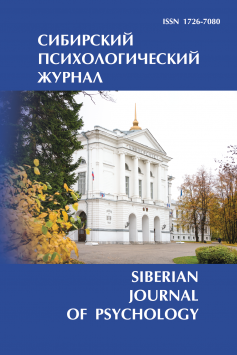Comparative analysis of perception strategies of true and false text
We believe that the characteristics of tendencies of how a person expresses and shapes an attitude of perception when interacting with the truth and lies are insufficiently studied aspects of the problem of perception and recognition of the truth and lies. The perception strategies of the truth and lies were characterized using 8 parameters. A certain combination of parameters defines the type of focus. It can be motivational (interest and involvement), cognitive (awareness and logic), affective (experience and emotionality), and authentic (confidence and realism). Results and Discussion. The perception strategies of the truth start to unfold based on the authentic-motivational and authentically-affective focuses while the focus of the perception of a false text was significantly different. It can be assumed that the strategy of perceiving a false text was formed on the basis of the affective focus involving the cognitive and authentic types of perception. Differences in the emotional parameter were found. The following differences in the realistic parameter were discovered: t = 2.3 at a = 0.05. The perception strategies of the truth and lies were different in their evaluation procedure for such types of focus as cognitive (awareness, logic), affective (emotionality), and authentic (realism). In terms of the emotional parameter lies were assessed higher than the truth. Participants evaluated "lies" as a less realistic statement than the "truth". This suggests that participants noticed the difference between the truth and deception. The cognitive-motivational and cognitive-authentic types of focuses prevailed in the perception strategies of the truth. Therefore, participants demonstrated a selective attitude towards the truth and lies. The ranking processes for the truth perception strategies were carried out on the basis of the authentic-motivational and authentic-affective vector of perception with the authentic focus playing the most important part. The ranking processes for the lies perception strategies were carried out on the basis of the cognitive-affective and authentic-affective vector of perception with the affective focus playing the most important part. Threefold strategies were mostly typical of the perception strategies of the truth. Singular, two- and fourfold strategies dominated in the perception strategies of lies. The truth was evaluated by placing the parameters of awareness and logic higher than lies. Which also speaks in favor of the potential abilities of people to recognize lies. Conclusion. The main hypothesis of the research was confirmed. General, typical, stable, as well as variable, and changeable components were identified. Motivational and cognitive focuses were classified as general stable components. This stable core was present in both perception strategies of the truth and lies. The results of the research show that people can still recognize false information to some extent.
Keywords
отношение, вектор, стратегия, направленность, валентность, избирательность, ранжирование, оценивание, отбор, attitude, vector, strategy, direction, valence, selectivity, ranking, evaluation, selectionAuthors
| Name | Organization | |
| Egorov Dmitry M. | Tomsk State University | e_dima@bk.ru |
| Bessmertnaya Irina A. | Tomsk State University | irina_immortal@mail.ru |
References
Comparative analysis of perception strategies of true and false text | Sibirskiy Psikhologicheskiy Zhurnal – Siberian Journal of Psychology. 2016. № 62. DOI: 10.17223/17267080/62/6
